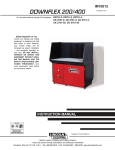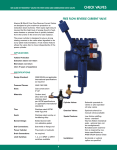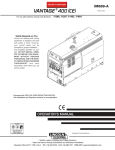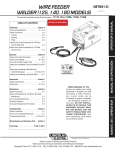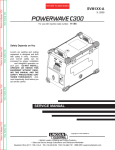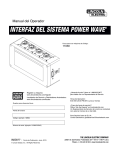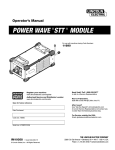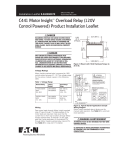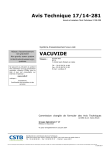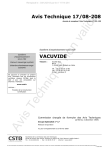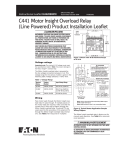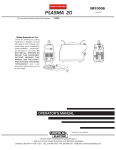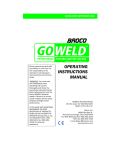Download Operator Manual English
Transcript
Operator’s Manual ® DownFlex 200/400 For use with machines having Code Numbers: K2751-2, K2751-3, K2751-6, K2751-8 Register your machine: www.lincolnelectric.com/register Authorized Service and Distributor Locator: www.lincolnelectric.com/locator Save for future reference Date Purchased Code: (ex: 10859) Serial: (ex: U1060512345) IM10013-A | Issue Date Nov-15 © Lincoln Global, Inc. All Rights Reserved. THANK YOU FOR SELECTING A QUALITY PRODUCT BY LINCOLN ELECTRIC. KEEP YOUR HEAD OUT OF THE FUMES. DON’T get too close to the arc. Use corrective lenses if necessary to stay a reasonable distance away from the arc. READ and obey the Material PLEASE EXAMINE CARTON AND EQUIPMENT FOR Safety Data Sheet (MSDS) and DAMAGE IMMEDIATELY the warning label that appears When this equipment is shipped, title passes to the purchaser upon on all containers of welding receipt by the carrier. Consequently, claims for material damaged in materials. shipment must be made by the purchaser against the transportation USE ENOUGH VENTILATION or company at the time the shipment is received. exhaust at the arc, or both, to keep the fumes and gases from your breathing zone and the general area. IN A LARGE ROOM OR OUTDOORS, natural ventilation may be adequate if you keep your head out of the fumes (See below). SAFETY DEPENDS ON YOU USE NATURAL DRAFTS or fans to keep the fumes away from your Lincoln arc welding and cutting equipment is designed and built face. with safety in mind. However, your overall safety can be increased If you develop unusual symptoms, see your supervisor. Perhaps the by proper installation ... and thoughtful operation on your part. welding atmosphere and ventilation system should be checked. DO NOT INSTALL, OPERATE OR REPAIR THIS EQUIPMENT WITHOUT READING THIS MANUAL AND THE SAFETY PRECAUTIONS CONTAINED THROUGHOUT. And, most importantly, WEAR CORRECT EYE, EAR & BODY PROTECTION think before you act and be careful. PROTECT your eyes and face with welding helmet properly fitted and with proper grade of filter plate (See ANSI Z49.1). PROTECT your body from welding spatter and arc WARNING flash with protective clothing including woolen clothing, flame-proof apron and gloves, leather This statement appears where the information must be followed leggings, and high boots. exactly to avoid serious personal injury or loss of life. PROTECT others from splatter, flash, and glare with protective screens or barriers. CAUTION IN SOME AREAS, protection from noise may be appropriate. This statement appears where the information must be followed to avoid minor personal injury or damage to this equipment. BE SURE protective equipment is in good condition. Also, wear safety glasses in work area AT ALL TIMES. SPECIAL SITUATIONS DO NOT WELD OR CUT containers or materials which previously had been in contact with hazardous substances unless they are properly cleaned. This is extremely dangerous. DO NOT WELD OR CUT painted or plated parts unless special precautions with ventilation have been taken. They can release highly toxic fumes or gases. Additional precautionary measures PROTECT compressed gas cylinders from excessive heat, mechanical shocks, and arcs; fasten cylinders so they cannot fall. BE SURE cylinders are never grounded or part of an electrical circuit. REMOVE all potential fire hazards from welding area. ALWAYS HAVE FIRE FIGHTING EQUIPMENT READY FOR IMMEDIATE USE AND KNOW HOW TO USE IT. SAFETY SECTION A: WARNINGS 1.d. Keep all equipment safety guards, covers and devices in position and in good repair. Keep hands, hair, clothing and tools away from V-belts, gears, fans and all other moving parts when starting, operating or repairing equipment. CALIFORNIA PROPOSITION 65 WARNINGS Diesel Engines 1.e. In some cases it may be necessary to remove safety guards to perform required maintenance. Remove guards only when necessary and replace them when the maintenance requiring their removal is complete. Always use the greatest care when working near moving parts. Diesel engine exhaust and some of its constituents are known to the State of California to cause cancer, birth defects, and other reproductive harm. Gasoline Engines 1.f. Do not put your hands near the engine fan. Do not attempt to override the governor or idler by pushing on the throttle control rods while the engine is running. The engine exhaust from this product contains chemicals known to the State of California to cause cancer, birth defects, or other reproductive harm. 1.g. To prevent accidentally starting gasoline engines while turning the engine or welding generator during maintenance work, disconnect the spark plug wires, distributor cap or magneto wire as appropriate. ARC WELDING CAN BE HAZARDOUS. PROTECT YOURSELF AND OTHERS FROM POSSIBLE SERIOUS INJURY OR DEATH. KEEP CHILDREN AWAY. PACEMAKER WEARERS SHOULD CONSULT WITH THEIR DOCTOR BEFORE OPERATING. 1.h. To avoid scalding, do not remove the radiator pressure cap when the engine is hot. Read and understand the following safety highlights. For additional safety information, it is strongly recommended that you purchase a copy of “Safety in Welding & Cutting - ANSI Standard Z49.1” from the American Welding Society, P.O. Box 351040, Miami, Florida 33135 or CSA Standard W117.2-1974. A Free copy of “Arc Welding Safety” booklet E205 is available from the Lincoln Electric Company, 22801 St. Clair Avenue, Cleveland, Ohio 441171199. BE SURE THAT ALL INSTALLATION, OPERATION, MAINTENANCE AND REPAIR PROCEDURES ARE PERFORMED ONLY BY QUALIFIED INDIVIDUALS. ELECTRIC AND MAGNETIC FIELDS MAY BE DANGEROUS 2.a. Electric current flowing through any conductor causes localized Electric and Magnetic Fields (EMF). Welding current creates EMF fields around welding cables and welding machines 2.b. EMF fields may interfere with some pacemakers, and welders having a pacemaker should consult their physician before welding. FOR ENGINE POWERED EQUIPMENT. 2.c. Exposure to EMF fields in welding may have other health effects which are now not known. 2.d. All welders should use the following procedures in order to minimize exposure to EMF fields from the welding circuit: 1.a. Turn the engine off before troubleshooting and maintenance work unless the maintenance work requires it to be running. 2.d.1. Route the electrode and work cables together - Secure them with tape when possible. 1.b. Operate engines in open, well-ventilated areas or vent the engine exhaust fumes outdoors. 2.d.2. Never coil the electrode lead around your body. 2.d.3. Do not place your body between the electrode and work cables. If the electrode cable is on your right side, the work cable should also be on your right side. 1.c. Do not add the fuel near an open flame welding arc or when the engine is running. Stop the engine and allow it to cool before refueling to prevent spilled fuel from vaporizing on contact with hot engine parts and igniting. Do not spill fuel when filling tank. If fuel is spilled, wipe it up and do not start engine until fumes have been eliminated. 2.d.4. Connect the work cable to the workpiece as close as possible to the area being welded. 2.d.5. Do not work next to welding power source. 3 SAFETY ELECTRIC SHOCK CAN KILL. ARC RAYS CAN BURN. 3.a. The electrode and work (or ground) circuits are electrically “hot” when the welder is on. Do not touch these “hot” parts with your bare skin or wet clothing. Wear dry, hole-free gloves to insulate hands. 4.a. Use a shield with the proper filter and cover plates to protect your eyes from sparks and the rays of the arc when welding or observing open arc welding. Headshield and filter lens should conform to ANSI Z87. I standards. 3.b. Insulate yourself from work and ground using dry insulation. Make certain the insulation is large enough to cover your full area of physical contact with work and ground. 4.b. Use suitable clothing made from durable flame-resistant material to protect your skin and that of your helpers from the arc rays. 4.c. Protect other nearby personnel with suitable, non-flammable screening and/or warn them not to watch the arc nor expose themselves to the arc rays or to hot spatter or metal. In addition to the normal safety precautions, if welding must be performed under electrically hazardous conditions (in damp locations or while wearing wet clothing; on metal structures such as floors, gratings or scaffolds; when in cramped positions such as sitting, kneeling or lying, if there is a high risk of unavoidable or accidental contact with the workpiece or ground) use the following equipment: FUMES AND GASES CAN BE DANGEROUS. 5.a. Welding may produce fumes and gases hazardous to health. Avoid breathing these fumes and gases. When welding, keep your head out of the fume. Use enough ventilation and/or exhaust at the arc to keep fumes and gases away from the breathing zone. When welding with electrodes which require special ventilation such as stainless or hard facing (see instructions on container or MSDS) or on lead or cadmium plated steel and other metals or coatings which produce highly toxic fumes, keep exposure as low as possible and within applicable OSHA PEL and ACGIH TLV limits using local exhaust or mechanical ventilation. In confined spaces or in some circumstances, outdoors, a respirator may be required. Additional precautions are also required when welding on galvanized steel. • Semiautomatic DC Constant Voltage (Wire) Welder. • DC Manual (Stick) Welder. • AC Welder with Reduced Voltage Control. 3.c. In semiautomatic or automatic wire welding, the electrode, electrode reel, welding head, nozzle or semiautomatic welding gun are also electrically “hot”. 3.d. Always be sure the work cable makes a good electrical connection with the metal being welded. The connection should be as close as possible to the area being welded. 3.e. Ground the work or metal to be welded to a good electrical (earth) ground. 3.f. Maintain the electrode holder, work clamp, welding cable and welding machine in good, safe operating condition. Replace damaged insulation. 5. b. The operation of welding fume control equipment is affected by various factors including proper use and positioning of the equipment, maintenance of the equipment and the specific welding procedure and application involved. Worker exposure level should be checked upon installation and periodically thereafter to be certain it is within applicable OSHA PEL and ACGIH TLV limits. 3.g. Never dip the electrode in water for cooling. 3.h. Never simultaneously touch electrically “hot” parts of electrode holders connected to two welders because voltage between the two can be the total of the open circuit voltage of both welders. 3.i. When working above floor level, use a safety belt to protect yourself from a fall should you get a shock. 5.c. Do not weld in locations near chlorinated hydrocarbon vapors coming from degreasing, cleaning or spraying operations. The heat and rays of the arc can react with solvent vapors to form phosgene, a highly toxic gas, and other irritating products. 3.j. Also see Items 6.c. and 8. 5.d. Shielding gases used for arc welding can displace air and cause injury or death. Always use enough ventilation, especially in confined areas, to insure breathing air is safe. 5.e. Read and understand the manufacturer’s instructions for this equipment and the consumables to be used, including the material safety data sheet (MSDS) and follow your employer’s safety practices. MSDS forms are available from your welding distributor or from the manufacturer. 5.f. Also see item 1.b. 4 SAFETY WELDING AND CUTTING SPARKS CAN CAUSE FIRE OR EXPLOSION. CYLINDER MAY EXPLODE IF DAMAGED. 7.a. Use only compressed gas cylinders containing the correct shielding gas for the process used and properly operating regulators designed for the gas and pressure used. All hoses, fittings, etc. should be suitable for the application and maintained in good condition. 6.a. Remove fire hazards from the welding area. If this is not possible, cover them to prevent the welding sparks from starting a fire. Remember that welding sparks and hot materials from welding can easily go through small cracks and openings to adjacent areas. Avoid welding near hydraulic lines. Have a fire extinguisher readily available. 7.b. Always keep cylinders in an upright position securely chained to an undercarriage or fixed support. 6.b. Where compressed gases are to be used at the job site, special precautions should be used to prevent hazardous situations. Refer to “Safety in Welding and Cutting” (ANSI Standard Z49.1) and the operating information for the equipment being used. 7.c. Cylinders should be located: 6.c. When not welding, make certain no part of the electrode circuit is touching the work or ground. Accidental contact can cause overheating and create a fire hazard. • Away from areas where they may be struck or subjected to physical damage. • A safe distance from arc welding or cutting operations and any other source of heat, sparks, or flame. 7.d. Never allow the electrode, electrode holder or any other electrically “hot” parts to touch a cylinder. 6.d. Do not heat, cut or weld tanks, drums or containers until the proper steps have been taken to insure that such procedures will not cause flammable or toxic vapors from substances inside. They can cause an explosion even though they have been “cleaned”. For information, purchase “Recommended Safe Practices for the Preparation for Welding and Cutting of Containers and Piping That Have Held Hazardous Substances”, AWS F4.1 from the American Welding Society (see address above). 7.e. Keep your head and face away from the cylinder valve outlet when opening the cylinder valve. 7.f. Valve protection caps should always be in place and hand tight except when the cylinder is in use or connected for use. 7.g. Read and follow the instructions on compressed gas cylinders, associated equipment, and CGA publication P-l, “Precautions for Safe Handling of Compressed Gases in Cylinders,” available 6.e. Vent hollow castings or containers before heating, cutting or welding. They may explode. from the Compressed Gas Association 1235 Jefferson Davis Highway, Arlington, VA 22202. 6.f. Sparks and spatter are thrown from the welding arc. Wear oil free protective garments such as leather gloves, heavy shirt, cuffless trousers, high shoes and a cap over your hair. Wear ear plugs when welding out of position or in confined places. Always wear safety glasses with side shields when in a welding area. FOR ELECTRICALLY POWERED EQUIPMENT. 6.g. Connect the work cable to the work as close to the welding area as practical. Work cables connected to the building framework or other locations away from the welding area increase the possibility of the welding current passing through lifting chains, crane cables or other alternate circuits. This can create fire hazards or overheat lifting chains or cables until they fail. 8.a. Turn off input power using the disconnect switch at the fuse box before working on the equipment. 6.h. Also see item 1.c. 8.b. Install equipment in accordance with the U.S. National Electrical Code, all local codes and the manufacturer’s recommendations. 6.I. Read and follow NFPA 51B “ Standard for Fire Prevention During Welding, Cutting and Other Hot Work”, available from NFPA, 1 Batterymarch Park, PO box 9101, Quincy, Ma 022690-9101. 8.c. Ground the equipment in accordance with the U.S. National Electrical Code and the manufacturer’s recommendations. 6.j. Do not use a welding power source for pipe thawing. Refer to http://www.lincolnelectric.com/safety for additional safety information. Welding Safety Interactive Web Guide for mobile devices 5 SAFETY As a rule of thumb, for many mild steel electrode, if the air is visibly clear and you are comfortable, then the ventilation is generally adequate for your work. The most accurate way to determine if the worker exposure does not exceed the applicable exposure limit for compounds in the fumes and gases is to have an industrial hygienist take and analyze a sample of the air you are breathing. This is particularly important if you are welding with stainless, hardfacing or Special Ventilation products. All Lincoln MSDS have a maximum fume guideline number. If exposure to total fume is kept below that number, exposure to all fume from the electrode (not coatings or plating on the work) will be below the TLV. There are steps that you can take to identify hazardous substances in your welding environment. Read the product label and material safety data sheet for the electrode posted in the work place or in the electrode or flux container to see what fumes can be reasonably expected from use of the product and to determine if special ventilation is needed. Secondly, know what the base metal is and determine if there is any paint, plating, or coating that could expose you to toxic fumes and/or gases. Remove it from the metal being welded, if possible. If you start to feel uncomfortable, dizzy or nauseous, there is a possibility that you are being overexposed to fumes and gases, or suffering from oxygen deficiency. Stop welding and get some fresh air immediately. Notify your supervisor and coworkers so the situation can be corrected and other workers can avoid the hazard. Be sure you are following these safe practices, the consumable labeling and MSDS to improve the ventilation in your area. Do not continue welding until the situation has been corrected. Ventilation There are many methods which can be selected by the user to provide adequate ventilation for the specific application. The following section provides general information which may be helpful in evaluating what type of ventilation equipment may be suitable for your application. When ventilation equipment is installed, you should confirm worker exposure is controlled within applicable OSHA PEL and/or ACGIH TLV. According to OSHA regulations, when welding and cutting (mild steels), natural ventilation is usually considered sufficient to meet requirements, provided that: 1. The room or welding area contains at least 10,000 cubic feet (about 22' x 22' x 22') for each welder. 2. The ceiling height is not less than 16 feet. 3. Cross ventilation is not blocked by partitions, equipment, or other structural barriers. 4. Welding is not done in a confined space. Spaces that do not meet these requirements should be equipped with mechanical ventilating equipment that exhausts at least 2000 CFM of air for each welder, except where local exhaust hoods or booths, or air-line respirators are used. Important Safety Note: When welding with electrodes which require special ventilation such as stainless or hardfacing (see instructions on container or MSDS) or on lead or cadmium plated steel and other metals or coatings which produce hazardous fumes, keep exposure as low as possible and below exposure limit values (PEL and TLV) for materials in the fume using local exhaust or mechanical ventilation. In conned spaces or in some circumstances, for example outdoors, a respirator may be required if exposure cannot be controlled to the PEL or TLV. (See MSDS and chart of TLV and PEL for Typical Electrode Ingredients.) Additional precautions are also required when welding on galvanized steel. NOTE: The MSDS for all Lincoln consumables is available on Lincoln’s website: www.lincolnelectric.com Before we turn to the methods available to control welding fume exposure, you should understand a few basic terms: Natural Ventilation is the movement of air through the workplace caused by natural forces. Outside, this is usually the wind. Inside, this may be the flow of air through open windows and doors. Mechanical Ventilation is the movement of air through the workplace caused by an electrical device such as a portable fan or permanently mounted fan in the ceiling or wall. Source Extraction (Local Exhaust) is a mechanical device used to capture welding fume at or near the arc and filter contaminants out of the air. The ventilation or exhaust needed for your application depends upon many factors such as: • Workspace volume • Workspace configuration • Number of welders • Welding process and current • Consumables used (mild steel, hardfacing, stainless, etc.) • Allowable levels (TLV, PEL, etc.) • Material welded (including paint or plating) • Natural airflow Your work area has adequate ventilation when there is enough ventilation and/or exhaust to control worker exposure to hazardous materials in the welding fumes and gases so the applicable limits for those materials is not exceeded. See chart of TLV and PEL for Typical Electrode Ingredients, the OSHA PEL (Permissible Exposure Limit), and the recommended guideline, the ACGIH TLV (Threshold Limit Value), for many compounds found in welding fume. 6 SAFETY BIBLIOGRAPHY AND SUGGESTED READING ANSI, Standard Z49.1, Safety in Welding, Cutting and Allied Processes. Z49.1 is now available for download at no charge at http://www.lincolnelectric.com/community/safety/ or at the AWS website http://www.aws.org. AWS F1.1, Method for Sampling Airborne Particulates Generated by Welding and Allied Processes. AWS F1.2, Laboratory Method for Measuring Fume Generation Rates and Total Fume Emission of Welding and Allied Processes. ANSI Z87.1, Practice for Occupational and Educational Eye and Face Protection, American National Standards Institute, 11 West 42nd Street, New York, NY 10036. Arc Welding and Your Health: A Handbook of Health Information for Welding. Published by The American Industrial Hygiene Association, 2700 Prosperity Avenue, Suite 250, Fairfax, VA 22031-4319. NFPA Standard 51B, Cutting and Welding Processes, National Fire Protection Association, 1 Batterymarch Park, P.O. Box 9146, Quincy, MA 02269-9959. OSHA General Industry Standard 29 CFR 1910 Subpart Q. OSHA Hazard Communication Standard 29 CFR 1910.1200. Available from the Occupational Safety and Health Administration at http://www.osha.org or contact your local OSHA office. The following publications are published by The American Welding Society, P.O. Box 351040, Miami, Florida 33135. AWS publications may be purchased from the American Welding society at http://www.aws.org or by contacting the AWS at 800-443-9353. INGREDIENTS AWS F1.3, Evaluating Contaminants in the Welding Environment: A Strategic Sampling Guide. AWS F1.5, Methods for Sampling and Analyzing Gases from Welding and Allied Processes. AWS F3.2, Ventilation Guide for Welding Fume Control AWS F4.1, Recommended Safe Practices for the Preparation for Welding and Cutting of Containers and Piping That Have Held Hazardous Substances. AWS SHF, Safety and Health Facts Sheets. Available free of charge from the AWS website at http://www.aws.org. LISTED BELOW ARE SOME TYPICAL INGREDIENTS IN WELDING ELECTRODES AND THEIR TLV (ACGIH) GUIDELINES AND PEL (OSHA) EXPOSURE LIMITS CAS No. Aluminum and/or aluminum alloys (as AI)***** 7429-90-5 Chromium and chromium alloys or compounds (as Cr)***** 7440-47-3 Aluminum oxide and/or Bauxite***** 1344-28-1 Barium compounds (as Ba)***** 513-77-9 TLV mg/m3 1.0 1.0 0.5 0.5(b) PEL mg/m3 15 5** 0.5 0.5(b) Hexavalent Chromium (Cr VI) 18540-29-9 0.05(b) .005(b) Fluorides (as F) 7789-75-5 2.5 2.5 Copper Fume 7440-50-8 Cobalt Compounds 7440-48-4 Iron Limestone and/or calcium carbonate 7439-89-6 1317-65-3 Lithium compounds (as Li) 554-13-2 Magnesite 1309-48-4 Magnesium and/or magnesium alloys and compounds (as Mg) Manganese and/or manganese alloys and compounds (as Mn)***** Mineral silicates Molybdenum alloys (as Mo) Nickel***** Silicates and other binders Silicon and/or silicon alloys and compounds (as Si) Strontium compounds (as Sr) 7439-95-4 Supplemental Information: 0.02 10* 10* 15 10* 10 7440-02-0 0.1 7439-98-7 0.1 10* 15 0.02 1332-58-7 0.1 10* 10* 7439-96-5 5** 10 15 5.0(c) 5** 10 1 1344-09-8 7440-21-3 10* 10* 10* 10* 12004-83-0 5 5 1633-05-2 Zirconium alloys and compounds (as Zr) 0.2 10* 10* (*) Not listed. Nuisance value maximum is 10 milligrams per cubic meter. PEL value for iron oxide is 10 milligrams per cubic meter. TLV value for iron oxide is 5 milligrams per cubic meter. (c) Values are for manganese fume. STEL (Short Term Exposure Limit) is 3.0 milligrams per cubic meter. OSHA PEL is a ceiling value. (*****) Subject to the reporting requirements of Sections 311, 312, and 313 of the Emergency Planning and Community Rightto-Know Act of 1986 and of 40CFR 370 and 372. TLV and PEL values are as of October 2013. Always check Safety Data Sheet (SDS) with product or on the Lincoln Electric website at http://www.lincolnelectric.com (**) As respirable dust. (****) The TLV for soluble barium compounds is 0.5 mg/m3. (b) The PEL for chromium (VI) is .005 milligrams per cubic meter as an 8 hour time weighted average. The TLV for water-soluble chromium (VI) is 0.05 milligrams per cubic meter. The TLV for insoluble chromium (VI) is 0.01 milligrams per cubic meter. 7 TABLE OF CONTENTS vi Page Installation.......................................................................................................................Section A Technical Specifications.......................................................................................................A-1 General Description..............................................................................................................A-2 Intended Use ........................................................................................................................A-2 Components .........................................................................................................................A-2 Installation......................................................................................................................A-3/A-5 Installation Of Remaining Options .................................................................................A-5/A-8 Electrical Connection............................................................................................................A-9 Connection To The Input Power.........................................................................................A-10 Direction Of Rotation ..........................................................................................................A-11 Operation.........................................................................................................................Section B General Description..............................................................................................................B-1 Operation..............................................................................................................................B-1 Safety Precautions ...............................................................................................................B-1 Filter Replacement ...............................................................................................................B-3 DownFlex 200-M (Only) .......................................................................................................B-5 DownFlex 400-MS/A (Only)..................................................................................................B-6 Accessories .....................................................................................................Section C Maintenance ....................................................................................................................Section D Safety Precautions ...............................................................................................................D-1 Maintenance.........................................................................................................................D-1 Periodic Maintenance...........................................................................................................D-2 Disposal ...............................................................................................................................D-2 Troubleshooting .............................................................................................................Section E How To Use Troubleshooting Guide ....................................................................................E-1 Troubleshooting Guide ..................................................................................................E-2/E-4 Wiring Diagrams .............................................................................................................Section D DownFlex 200-M ............................................................................................................F-1/F-3 208-240V/3~/60Hz (USA)..............................................................................................F-1 480V/3~/60Hz (USA).....................................................................................................F-2 600V/3~/60Hz (CANADA) .............................................................................................F-3 DownFlex 400-MS/A ......................................................................................................F-4/F-6 208-240V/3~/60Hz (USA)..............................................................................................F-4 480V/3~/60Hz (USA).....................................................................................................F-5 600V/3~/60Hz (USA).....................................................................................................F-6 Parts .................................................................................................parts.lincolnelectric.com Content/details may be changed or updated without notice. For most current Instruction Manuals or Parts Page, go to parts.lincolnelectric.com. vi INSTALLATION A-1 A-1 TECHNICAL SPECIFICATIONS - DOWNFLEX 200/400 DIMENSIONS L x W x H Downdraft Table Downdraft Table incl. Backdraft Kit and Side Panels 54.3 x 39.4 x 36.2 in. (1380 x 1005 x 920 mm) 54.3 x 39.4 x 60.8 in. (1380 x 1005 x 1543 mm) HEIGHT ADJUSTMENT 36 - 38 in. / 920 - 970 mm (in case of wheel kit: fixed working height 37.4 in. / 950 mm) WEIGHT (Without Backdraft Kit, Side Panels And Other Options) DownFlex 200-M DownFlex 400-MS/A 540 lbs. (245 kg) 562 lbs. (255 kg) MAXIMUM LOAD 440 lbs. (200 kg) (In Case Of Wheel Kit: 330 lbs. (150kg)) CONNECTION VOLTAGE USA - 208-240V/480V/3ph/60Hz CANADA - 600V/3ph/60Hz DEFAULT SETTING USA 480V POWER CONSUMPTION 3 kw (4HP) MAINS CORD 10 ft. / 3 m (3.3 ft. / 1 m internal, 6.6 ft. / 2 m external) - without plug PROTECTION CLASS Without Options With Silencer With Silencer And HEPA Kit NEMA 1 (control box only) SOUND LEVEL MAIN FILTER SURFACE AREA 2 x 280 ft2 (2 x 26 m2) 78 db(A) 74 db(A) 71 db(A) FILTER CLASS ACCORDING TO DIN EN 60335-2-69 Min. Operating Temp 41ºF (5ºC) M AMBIENT CONDITIONS Nom. Operating Temp 68ºF (20ºC) Max. Operating Temp 104ºF (40ºC) DownFlex 400-MS/A only: Compressed Air Connection Compressed Air Pressure Required Compressed Air Quality DOWNFLEX 200/400 Max. Relative Humidity 80% 3/8” (female) 72 - 115 psi (5 - 8 bar) dry and oil-free A-2 GENERAL DESCRIPTION INSTALLATION The downdraft table is a workbench with an integrated extraction fan and filtration system that is used for welding, grinding and plasma cutting applications. Depending on the specific application, the use of certain accessories is required and/or recommended. See Accessories section of this manual. FIGURE A.1 – COMPONENTS G A B The downdraft table features a work grid, a threestage prefiltration system for optimum spark arresting and two oval main filter cartridges. Both pre and main filters have dust drawers underneath. The working height of the downdraft table is adjustable. INTENDED USE A-2 C D E The product has been designed as a workbench with integrated extraction and filtration facility for welding and grinding purposes, provided the appropriate options have been installed (See Accessories Section of this manual). Using the product for other purposes is considered contrary to its intended use. The manufacturer accepts no liability for any damage or injury resulting from such use. The product has been built in accordance with state-of-the-art standards and recognized safety regulations. Only use this product when in technically perfect condition in accordance with its intended use and the instructions explained in the user manual. K. Filter cleaning mechanism (DownFlex 400-MS/A only) L. Filter cartridges (2) M. Prefilters (2nd stage) N. Fan O. Outlet grid P. Electrics high voltage Q. Electrics low voltage COMPONENTS The downdraft table consists of the following main components See Figures A.1 and A.2: FIGURE A.2 – COMPONENTS A. Backdraft kit B. Side panels (left + right) C. Work grid (two-piece) H D. Control panel E. Left door (controls/fan) I Q F. Right door (filter compartment) F G. Compressed air tank (DownFlex 400-MS/A only) H. Prefilters (1st stage; located under work grid) I. Dust drawers (prefiltration) J. Dust drawer (main filter cartridges) P ON DOWNFLEX 200/400 ML KJ A-3 INSTALLATION INSTALLATION 4. Tighten the bolts. TOOLS AND REQUIREMENTS The following tools and requirements are needed to install the product: • Spanner M6 and M8 • Hexagon wrench 10 and 13 (1/2 in.) UNPACKING Check that the product is complete. The package should contain: • Downdraft table • Work grid (two-piece) • Cover strip with 8 bolts M6 (cover strip not included when backdraft kit and side panels are standard equipment; bolts packed with backdraft kit) • Square key 8 mm (to lock/unlock doors) • Square key 6 mm (to lock/unlock dust drawers and doors of electrics) If parts are missing or damaged, contact your supplier. OPTIONS Mount optional side panels, back panel, backdraft kit, and/or plasma cutting work grid, if any. Otherwise, refer to Work Grid for mounting of work grid. SIDE PANELS Side panels are to be mounted to the back panel or backdraft kit. See Figure A.3. To mount the side panels, proceed as follows. 1. Unscrew the bolts on the loose side of the hinges and remove the washers; keep the bolts and washers. 2. Put the pins through the holes on the sides of the back panel or backdraft panel. 3. Place the washers and bolts over the pins. FIGURE A.3 – SIDE PANELS A-3 BACK PANEL To mount the back panel, proceed as follows. See Figure A.4. 1. Unscrew the cover strip. 2. Place the back panel (A). See Figure A.4. 3. Place the cover strip (B) inside the back panel. See Figure A.4. 4. Fasten the back panel and cover strip using the 8 bolts. FIGURE A.4 – BACK PANEL A B BACKDRAFT KIT The backdraft kit consists of: • Backdraft panel • 2 Narrowing plates NOTE: When the downdraft table will be used for grinding only, it is not necessary to mount the narrowing plates. For welding and plasma cutting, however, the narrowing plates are required. To mount the backdraft kit, proceed as follows. 1. Unscrew the cover strip. (Keep the 8 bolts) NOTE: Downdraft table contains no cover strip when backdraft kit and side panels are standard equipment; bolts packed with backdraft kit. 2. Place the narrowing plates (C). See Figure A.5. 3. Place the backdraft panel (A). See Figure A.5. 4. Fasten the narrowing plates and the backdraft panel using the 8 bolts (B). See Figure A.5. The supplied cover strip is not used. DOWNFLEX 200/400 INSTALLATION A-4 A-4 FIGURE A.6 – PLASMA CUTTING WORK GRID FIGURE A.5 – BACKDRAFT KIT A B C A PLASMA CUTTING WORK GRID The plasma cutting work grid consists of: • 2 Grid frames 28.9 x 26.3 x 2.5 in. (735 x 669 x 64 mm) B • 2 x 13 Metal bars 28.54 x 2.36 x 0.16 in. (725 x 60 x 4 mm) • 2 Additional perforated steel spark arresters To mount the plasma cutting work grid, proceed as follows. 1. Place the perforated steel spark arresters over the prefilters (A). The edgeless sides should be directed to the back. See Figure A.6. CAUTION Do not remove the standard prefilters. -----------------------------------------------------------------------2. Remove the ground bracket at the position of the work grid. Keep the two bolts. 3. Place the frames into position. C (x26) 4. Fasten the frames using the 2 bolts (B). See Figure A.6. NOTE: It is necessary to install the bolts to ground the work grids. 5. Place the bars (C). See Figure A.6. NOTE: The supplied standard work grid and the ground bracket are not used. DOWNFLEX 200/400 INSTALLATION A-5 WORK GRID To mount the standard work grid, proceed as follows. See Figure A.7. 1. Loosen the ground bracket. 2. Place the work grids into position. 3. Place the ground bracket over both work grids. 4. Tighten the ground bracket. FIGURE A.7 – WORK GRID A-5 3. Unlock the HEPA filter cartridge by pressing a screwdriver or other tool at the position of the strips (B) on the top and bottom of unit. See Figure A.8. 4. Take out the filter cartridge. 5. Mount the adjustable feet underneath the HEPA kit. NOTE: Remove the outlet panel from the HEPA kit, as well as the outlet grid inside the downdraft table, to facilitate mounting. Don’t forget to replace them when mounting is complete. 6. Place bolts halfway through the 2 upper holes (C) at the outlet of the downdraft table. See Figure A.8. 7. Hang the HEPA box on the bolts. 8. Place bolts through the 2 lower holes (D) in the HEPA box. See Figure A.8. 9. Fasten the HEPA box by tightening the 4 bolts (C+D). See Figure A.8. 10. Replace the filter cartridge. NOTE: It is necessary to install the bracket to ground the work grids. INSTALLATION OF REMAINING OPTIONS HEPA KIT ATTENTION 11. Lock the filter cartridge by pulling the two straps tightly. This is indicated by a “click” sound. NOTE: If a Silencer/Outlet duct has to be installed as well, the outlet panel of the HEPA kit does not need to be mounted. 12. Adjust the feet when the downdraft table is placed in place in its final position. NOTE: The outlet panel of the downdraft table is not used. Handle HEPA box and filter cartridge with care during unpacking and mounting to avoid damage. ------------------------------------------------------------------------ The HEPA kit consists of: • HEPA box with filter • 2 Adjustable feet • 4 Spare bolts M6 • Draft strip To mount the HEPA kit, proceed as follows. 1. Unscrew and remove the outlet panel from the downdraft table. Keep he 4 screws See Figure A.8, top image. 2. Apply the draft strip to the downdraft table (A). See Figure A.8. DOWNFLEX 200/400 A-6 A FIGURE A.8 – HEPA KIT INSTALLATION A-6 3. Place bolts halfway through the 2 lower holes at the outlet of the downdraft table or HEPA box (C). See Figure A.9. 4. Place the silencer/outlet duct over the bolts (D). See Figure A.9. 5. Put the silencer/outlet duct in an upright position and place 2 bolts in the 2 upper holes. 6. Fasten the silencer/outlet duct by tightening the 4 bolts (E). See Figure A.9. NOTE: The outlet panel of the downdraft table is not used. FIGURE A.9 – SILENCER / OUTLET DUCT B (2x) C (x2) B A C (x2) D (x2) SILENCER/OUTLET DUCT The Silencer/Outlet duct consists of: • Shaft • Draft strip D The Silencer/outlet duct can be connected to the HEPA kit or directly to the downdraft table. To mount the silencer/outlet duct, proceed as follows. See Figure A.9. 1. If necessary: unscrew the outlet panel of the downdraft table or the outlet panel of the HEPA kit. Keep the 4 bolts. 2. Apply the draft strip to the downdraft table (A) or HEPA kit (B). See Figure A.9. E (x4) DOWNFLEX 200/400 INSTALLATION A-7 WORKING LIGHT A-7 MOVEMENT SENSOR The working light consists of: • Lighting fixture with 7.5 ft (2.3 m) of cable and plug • 6 Bolts M6 • 3 Tie-wraps To mount the working light, proceed as follows. 1. Mount the lighting fixture using the 6 bolts (A). See Figure A.10. 2. Route the cable down the back side of the downdraft table. 3. Attach the cable to the back panel or backdraft panel using the 3 tie-wraps (B). See Figure A.10. 4. Connect the cable. See Figure A.11, item B. FIGURE A.10 – WORKING LIGHT A (x6) (DownFlex 400-MS/A only) The movement sensor consists of: • Automatic start/stop device with 7.5 ft (2.3 m) of cable and plug • 2 Bolts M6 • 3 Tie-wraps To mount the movement sensor, proceed as follows. 1. Mount the movement sensor on top of the back panel or backdraft panel using the 2 bolts (A). See Figure A.12. 2. Lead the cable down the back side of the downdraft table. 3. Attach the cable to the back panel or backdraft panel using the 3 tie-wraps (B). See Figure A.12. 4. Connect the cable. See Figure A.11, item A. FIGURE A.12 – MOVEMENT SENSOR A (x2) -re ar- B (x3) -re ar- B (x3) FIGURE A.11 – CONNECTIONS A B C DOWNFLEX 200/400 A-8 WELDING CABLE SENSOR INSTALLATION WHEEL KIT (DownFlex 400-MS/A only) A-8 The wheel kit consists of: The welding cable sensor consists of: • 2 Swivel casters with brakes. • Clamp with 7.5 ft (2.3 m) of cable and plug. To mount the welding cable sensor, proceed as follows. 1. Connect the cable. See Figure A.11, item A. BENCH VICE MOUNTING BRACKET The bench vice mounting bracket can be mounted on the standard work grid only. The bench vice mounting bracket consists of: • 3 Swivel casters without brakes. To mount the wheel kit, proceed as follows. 1. Carefully lift the downdraft table using a fork-lift truck or pallet jack. 2. Unscrew the 5 adjustable feet. 3. Mount the swivel casters; mount the ones with brakes at the left and right front corners. NOTE: Drive in the screw thread of the swivel casters as deep as possible. NOTE: By the use of the wheel set, the working height of the downdraft table is fixed to 37.4 in. (950 mm). • Mounting bracket • 2 Strips • 4 Bolts M6 COMPRESSED AIR CONNECTION • 4 Nuts M6 • 8 Washers To mount the bench vice mounting bracket, proceed as follows. 1. Position the mounting bracket on the grid. 2. Place the strips underneath the grid and fasten them using the bolts, nuts and washers. See Figure A.13. 3. Place the strips underneath the grid and fasten them using (from bottom to top): nut - washer strip - grid - mounting bracket - washer - bolt. FIGURE A.13 – BENCH VICE MOUNTING BRACKET (DownFlex 400-MS/A only) The downdraft table cleaning mechanism functions on compressed air with a recommended working pressure of 72-115 psi (5-8 bar). Always make sure that the working pressure is between these values (preferably at 72 psi/5 bar). If required, mount a pressure reducing valve to prevent overpressure. If the pressure is too high, the safety valve of the system will be opened, thus decreasing the pressure until the system pressure has reached an appropriate level. 1. Connect the downdraft table to compressed air. See Figure A.11, item C. Connection ⅜ in. POSITIONING The downdraft table can be positioned using: • A fork-lift truck (preferred way); or • A pallet jack (downdraft table has to be tilted); or • Cargo lashings lifted by a fork-lift truck. See Figure A.14. DOWNFLEX 200/400 A-9 CAUTION INSTALLATION Do not position the product where it is exposed to vibrations or heat radiation from heat sources. Observe the earlier described ambient conditions. -----------------------------------------------------------------------FIGURE A.14 – CARGO LASHINGS WARNING A-9 • Lift only with equipment of adequate lifting capacity. • Be sure machine is stable when lifting. • Do not lift this machine using lift bail if it is equipped with a heavy accessory such as trailer or gas cylinder. • Do not lift machine if lift bail is FALLING EQUIPMENT can damaged. cause injury. • Do not operate machine while suspended from lift bail. ------------------------------------------------------------------------ ELECTRICAL CONNECTION CAUTION • Position the downdraft table against the wall. • If necessary, use the adjusting feet to level the downdraft table and to adjust it to the desired height (min. 36 in. - max. 38 in. 920-970 mm). See Figure A.15. FIGURE A.15 – ADJUSTABLE FEET 50 mm Make sure that the system is suitable for connection to the local input power. Information about the connection voltage and frequency can be found on the identification plate. The input power must be connected in conformance with the local codes and regulations and can only be installed by well qualified and authorized technicians. -----------------------------------------------------------------------If necessary: change motor from 480V to 208/240V Default setting of the motor is 480V. Depending on the local input power voltage, the setting could be changed to 208/240V. This concerns both the motor and the transformer. WARNING Make sure the downdraft table is disconnected from input power. ------------------------------------------------------------------------ DOWNFLEX 200/400 INSTALLATION A-10 A-10 FIGURE A.17 – CHANGE OF TRANSFORMER To change the motor from 480V to 208/240V, proceed as follows. 1. Open left door. 2. Loosen 4 screws from motor connection block (A) and remove cover. See Figure A.16. 3. Disconnect the 3 phase wires from the motor connection block. A FIGURE A.16 – MOTOR CONNECTION BLOCK A B A Cable jumpers and wiring diagram necessary to change the motor setting, are supplied in a plastic folder which can be found on the upper right side of the downdraft table. com YELLOW com 115V WHITE 115V WHITE 208V BROWN YELLOW 208V BROWN 240V VIOLET 240V VIOLET 277V ORANGE 277V ORANGE 400V BLUE 400V BLUE 480V GREY 480V GREY 600V BLACK 600V BLACK 480V HIGH VOLTAGE or 208/240V LOW VOLTAGE • Reconfigure the wiring from Y to YY in accordance with the wiring diagram. CONNECTION TO THE INPUT POWER To reconfigure the transformer, proceed as follows. See Figure A.17. 1. Mount a fuse in the local fuse box to which the downdraft table will be connected. Check the electrical diagram for the right type of fuse. Refer to the following table: • Replace cover of motor connection block. 1. Open door to access high voltage electronics. See Figure A.2, item Q. Transformer (A): To connect the downdraft table to the input power, proceed as follows. WARNING 2. Disconnect the wire from the primary 480V tap (grey) and reconnect the primary 208V tap (brown) or 240V tap (violet). Make sure the downdraft table is disconnected from input power. Overload relay (B): 3. Adjust overload relay to 10 Amps. 4. Close and lock all doors. -----------------------------------------------------------------------Electrical Diagram DownFlex 200-M DownFlex 400-MS/A DOWNFLEX 200/400 USA 208-240V 480V Figure # Figure # Canada 600V Figure # Figure F.1 Figure F.2 Figure F.3 Figure F.4 Figure F.5 Figure F.6 A-11 WARNING INSTALLATION Be sure to mount the right fuse type. Plugs/connections to be installed in accordance with the National Electrical Code (NEC) and local requirements. -----------------------------------------------------------------------The downdraft table can be connected to input power by: • 3ph plug (grounded); or • Directly to the power supply 1. Connect the main cord (A) to the input power. See Figure A.18. FIGURE A.18 – ELECTRIC CONNECTION WARNING A-11 Do not open the door within 20 seconds after switching off the fan. Keep your hands away from the fan wheel. ------------------------------------------------------------------------ DIRECTION OF ROTATION Check the direction of rotation of the fan. 1. Turn on the main switch. 2. Push the ON button to switch on the fan. 3. Push the OFF button to switch off the fan. 4. Wait 20 seconds. 5. Open the left door. The motor contains a sticker indicating the correct direction of rotation. 1. Check the direction of rotation during the slowdown period of the fan. 2. Turn off the main switch. 3. Disconnect the downdraft table from the input power. A 4. If the fan is rotating in the wrong direction change the connection of the phases. DOWNFLEX 200/400 B-1 GENERAL DESCRIPTION OPERATION The downdraft table is a workbench with an integrated extraction fan and filtration system that is used for welding, grinding and plasma cutting applications. Depending on the specific application, the use of certain accessories is required and/or recommended. See Accessories section of this manual. The downdraft table features a work grid, a threestage prefiltration system for optimum spark arresting and two oval main filter cartridges. Both pre and main filters have dust drawers underneath. The working height of the downdraft table is adjustable. DOWNFLEX 200-M The main filter cartridges of the DownFlex 200-M are disposable. A Magnehelic gauge on the control panel indicates when the filter cartridges need to be replaced. DOWNFLEX 400-MS/A The filter cleaning system inside the DownFlex 400MS/A starts automatically each time the fan is switched off (offline cleaning) and also when the pressure drop reaches a certain maximum value during use (online cleaning). The filter cartridges are cleaned from the inside by compressed air pulses. An integrated buzzer indicates when the filter cartridges need to be replaced. OPERATION The air containing welding fume, grinding dust or debris from other processes is extracted and filtered, after which the filtered air is recirculated back into the work environment. The air is extracted through the work grid and the backdraft panel (See Accessories section of this manual) by the internal extraction fan. The air passes through a prefilter for optimum air distribution. This prefilter is the first spark arresting stage. Next, the air passes through a labyrinth spark trap before it reaches the vertical prefilters in the main filter housing. Finally, the air passes through the main filter cartridges. The air exits the downdraft table through the outlet on the left side. SAFETY PRECAUTIONS B-1 WARNING FUMES AND GASES can be dangerous Welding may produce fumes and gases hazardous to health. Avoid breathing these fumes and gases. When welding, keep your head out of the fume. Use enough ventilation and/or exhaust at the arc to keep fumes and gases away from the breathing zone. When welding with electrodes which require special ventilation such as stainless or hard facing (see instructions on container or MSDS) or on lead or cadmium plated steel and other metals or coatings which produce highly toxic fumes, keep exposure as low as possible and within applicable OSHA PEL and ACGIH TLV limits using local exhaust or mechanical ventilation. In confined spaces or in some circumstances, outdoors, a respirator may be required. Additional precautions are also required when welding on galvanized steel. The operation of welding fume control equipment is affected by various factors including proper use and positioning of the equipment, maintenance of the equipment and the specific welding procedure and application involved. Worker exposure level should be checked upon installation and periodically thereafter to be certain it is within applicable OSHA PEL and ACGIH TLV. ------------------------------------------------------------------------ WARNING Never use the downdraft table without prefilters, main filter cartridges and dust drawers. ------------------------------------------------------------------------ WARNING Fire hazard! Never use the product for: • Filtering flammable, glowing or burning particles or solids or liquids. • Filtering of aggressive fumes (such as hydrochloric acid) or sharp particles. • Sucking cigarettes, cigars, oiled tissues, and other burning particles, objects, and acids. ------------------------------------------------------------------------ DOWNFLEX 200/400 B-2 WARNING OPERATION Never use the product for: • Oxy-fuel cutting. • Arc-air gouging. • Oil mist. • Paint mist. • Heavy oil mist in welding fume. • Extraction of hot gases (more than 45°C/113°F continuously). • Grinding aluminum and magnesium. • Flame spraying. • Extraction of cement, saw dust, wood dust etc. • Explosive environments or explosive substances/ gases. ------------------------------------------------------------------------ WARNING WARNING B-2 Moving parts (fan) may cause injury. After switching off the fan, wait at least 20 seconds before opening the door(s) to carry out service, maintenance or repair jobs. • Industrial vacuum cleaner used during service and maintenance should meet OSHA guidelines for Cr6 housekeeping. • Always use the downdraft table with prefilters, filter cartridges and dust drawers properly installed. ------------------------------------------------------------------------ In case of welding and plasma cutting, the use of a backdraft kit is required. -----------------------------------------------------------------------• Inspect the product and check it for damage. Verify the functioning of the safety features. • Check the working environment. Do not allow unauthorized persons to enter the working environment. • Protect the product against water and humidity. • Use common sense. Stay alert and keep your attention to your work. Do not use the product when you are under the influence of drugs, alcohol or medicine. • Make sure the room is always sufficiently ventilated; this applies especially to confined spaces. • Never install the product in front of entrances and exits which must be used for emergency services. • Make sure that the workshop in the vicinity of the product, contains sufficient approved fire extinguishers. • Maintenance should only be performed by authorized, qualified and trained persons (skilled) using appropriate work practices. • Always wear face mask and gloves during filter exchange / cleaning. DOWNFLEX 200/400 B-3 FILTER REPLACEMENT OPERATION FILTER CARTRIDGES AND PREFILTERS If the filter cartridges and/or prefilters are damaged or saturated, they need to be replaced. To replace the filter cartridges or prefilters, proceed as follows: FIGURE B.1 – FILTER REPLACEMENT WARNING • Always wear face mask and gloves during filter replacement. Other appropriate work clothing may be required to protect workers. -----------------------------------------------------------------------1. Turn off the main switch and remove the input power. 2. Unpack the replacement filter cartridges and prefilters. 3. Save plastic bag. Wear mask and gloves. 4. Wear mask and gloves. WARNING Wait at least 60 seconds before opening the door to allow the dust in the filter compartment to settle. -----------------------------------------------------------------------NOTE: Turn square key to the left to unlock the door. 5. Remove the used filter cartridges and pack them in the plastic bags in which the new filters are supplied. See Figure B.1. 6. Seal the bags firmly with the supplied tie-wrap. 7. Remove the prefilters (both 1st and 2nd stage); See Figure A.2, items H and M. 8. Clean dust trays, work surfaces and prefilters by using an industrial vacuum cleaner (HEPA where required) and wet wiping techniques. 9. If prefilters (1st and/or 2nd stage) are saturated, replace. 10. Seal prefilter bag firmly with supplied tie-wrap. 11. Install new filter cartridges in unit. 12. Close the door and turn on main switch. 13. Dispose of filter cartridges and prefilters in accordance with federal, state and/or local regulations. DOWNFLEX 200/400 B-3 B-4 HEPA FILTER (OPTIONAL) OPERATION The HEPA filter is supplied in a plastic bag and comes with face mask and a pair of disposable gloves. It should be replaced at the same time as the main filter cartridges. WARNING • Always wear face mask and gloves during filter replacement. Other appropriate work clothing may be required to protect workers. -----------------------------------------------------------------------1. Turn off the main switch and remove the input power. 2. Open door of HEPA kit. 3. Unlock the HEPA filter cartridge (See Figure A.8, item B). 4. Remove the used filter cartridge and pack it in the plastic bag in which the new filter is supplied. 5. Clean filter housing, using a HEPA industrial vacuum cleaner and wet wiping techniques. 6. Install new HEPA filter cartridge. 7. Close the door. 8. Dispose of materials in accordance with federal, state and/or local regulations. DOWNFLEX 200/400 B-4 B-5 DOWNFLEX 200-M (Only) OPERATION FILTER REPLACEMENT CONTROL PANEL The control panel is equipped with the following controls. (See Figure B.2): A. Main Switch B. Magnehelic Gauge C. ON Button 1. During use, regularly check the Magnehelic gauge (B). When the pressure reaches 0.25 psi (1700 Pa), the filter cartridges need to be replaced. See Figure B.2. 2. Refer to Filter Replacement for the filter replacement procedure. D. OFF Button FIGURE B.2 – CONTROL PANEL ON C OFF D B 548602 B-5 PLASMA CUTTING: – standard work grid: NO plasma cutting – plasma cutting work grid: max. 50 A OTHER APPLICATIONS: – READ THE MANUAL A OPERATION 1. Turn on the main switch (A). See Figure B.2. 2. Push the ON button (C) to switch on the fan. See Figure B.2. 3. Start welding/grinding. 4. After finishing welding/grinding, push the OFF button (D) to switch off the fan. See Figure B.2. 5. Turn switch (A) off to remove the main input power. DOWNFLEX 200/400 B-6 DOWNFLEX 400-MS/A (Only) OPERATION AUTOMATIC FILTER CLEANING Each time the downdraft table is switched off, the filter cartridges are automatically cleaned by a full cleaning cycle. This procedure takes approximately 7 minutes, during which each filter cartridge is cleaned by max. 10 compressed air blasts. CONTROL PANEL The control panel is equipped with the following controls. (See Figure B.3): A. Main Switch B. Magnehelic Gauge C. ON/OFF Button D. Button RESET ALARM/MANUAL CLEANING E. Buzzer FIGURE B.3 – CONTROL PANEL C RESET ALARM / MANUAL CLEANING REENCLENCHEMENT ALARME / DECOLMATAGE MANUEL APAGAR ALARMA / LIMPIEZA MANUAL D E B PLASMA CUTTING: – standard work grid: NO plasma cutting – plasma cutting work grid: max. 50 A MANUAL FILTER CLEANING 1. Push the ON/OFF button (C) to switch on the fan. See Figure B.3. 2. Press button RESET ALARM/MANUAL CLEANING (D) during 5 seconds to activate the filter cleaning system. See Figure B.3. This procedure takes approximately 4 minutes, during which each filter cartridge is cleaned by 6 compressed air blasts. NOTE: To secure optimum filter efficiency the filter cleaning system cannot be activated during the first 20 hours of operation or within 20 hours after filter replacement. BUZZER OTHER APPLICATIONS: – READ THE MANUAL A The buzzer may emit two different interrupted sounds: • 2 Seconds on - 2 seconds off: clogged filter OPERATION 1. Turn on the main switch (A). See Figure B.3. Without movement With movement sensor and sensor: welding cable sensor: • Push the ON/OFF button (C) to switch on the fan. • Start welding / grinding. • After finishing welding / grinding, push the ON / OFF button (C) to switch off the fan. NOTE: To secure optimum filter efficiency the filter cleaning system will not be activated during the first 20 hours of operation or within 20 hours after filter replacement. If desired, the filter cleaning system can be activated manually (online cleaning only). ON / OFF 548131 B-6 With welding cable sensor: (for welding only): • Start welding / • Apply the clamp grinding. of the welding The fan will start cable sensor to and stop autothe ground matically. cable of the welding machine. • Start welding. The fan will start and stop automatically. • 2 Seconds on - 5 seconds off: compressed air missing When the pressure over the filter cartridges reaches 0.22 psi (1500 Pa) during use, the buzzer will emit an interrupted sound (2 seconds on - 2 seconds off). In this case proceed as follows. 1. Press button RESET ALARM/MANUAL CLEANING (D) to deactivate the buzzer. See Figure B.3. 2. Push the ON/OFF button (C) to switch off the fan. See Figure B.3. DOWNFLEX 200/400 B-7 OPERATION After the fan has been switched off, the automatic filter cleaning procedure will be activated. See Automatic Filter Cleaning. NOTE: Buzzer sound is suppressed during one hour enabling the user to finish his job. If necessary/desired, buzzer can be suppressed (repeatedly), provided that the downdraft table is switched off by ON/OFF button at the end of the day. NOTE: When welding/grinding and cleaning is finished turn switch (A) off to remove the main input power. FILTER REPLACEMENT When the filter cleaning system is unable to get the pressure below 0.22 psi (1500 Pa) after 5 attempts, the filter cartridges are probably saturated and need to be replaced. This is indicated by the buzzer emitting an interrupted sound (2 seconds on - 2 seconds off). 1. Press button RESET ALARM/MANUAL CLEANING (D) to deactivate the buzzer (E). See Figure B.3. 2. Push the ON/OFF button (C) to switch off the fan. See Figure B.3. 3. Wait 20 seconds for fan to stop rotating. 4. Refer to Filter Replacement for the filter replacement procedure. DOWNFLEX 200/400 B-7 C-1 ACCESSORIES ACCESSORIES The following products are accessories for the DownFlex tables: CAUTION Backdraft kit and side panels are standard equipment. -----------------------------------------------------------------------A. Back Panel The back panel consists of a sheet metal plate to be mounted on the downdraft table. The back panel functions as a deflector plate for grinding applications. It also prevents tools, metal and other parts from falling behind the downdraft table. B. Backdraft Kit (required for all welding applications and recommended for grinding applications) The backdraft kit consists of narrowing plates to be mounted underneath the work grid and a backdraft panel with vertical lamellas. The backdraft kit is required for all welding and plasma cutting applications and recommended for grinding applications. By using the backdraft kit, the downdraft extraction capacity is reduced to approx. 20%. The remaining 80% is extracted through the backdraft panel. C. Side Panels The side panels consist of hinged trapezium-shaped sheet metal plates and have to be used in combination with the backdraft kit or back panel. They are to be mounted on the sides of the downdraft table. Side panels improve the extraction effectiveness by reducing the influences of draft. They also prevent tools, metal and other parts from falling off the downdraft table. Side panels are hinged to accommodate large workpieces. C-1 E. HEPA Kit Consists of a filter housing with a HEPA filter to be mounted on the outlet of the downdraft table. F. Silencer/Outlet Duct Consists of a rectangular sheet metal shaft to be mounted on the outlet of the downdraft table or on the HEPA kit. The Silencer/Outlet duct is to be used as a silencer and prevents dust from blowing up from the floor at the same time. In case the Silencer/Outlet duct is used in a welding cabin, it also prevents air turbulence in the cabin and air disturbance to any adjacent cabin. G. Outlet Connection Plate Outlet plate for duct connection of downdraft table. The outlet connection plate is to be mounted at the outlet of the downdraft table instead of the outlet panel. Suitable for mounting of a flange Ø 12 inch or Ø 315 mm for hose or duct connection; flange to be sourced locally. H. Working Light Lighting fixture with 18W fluorescent light to be mounted to the back panel or backdraft panel. The working light provides a clear view to the workpiece. The cover can be hinged to facilitate exchange of the fluorescent light. The working light is activated upon turning on the main switch of the downdraft table. I. Movement Sensor (DownFlex 400-MS/A only) Automatic start/stop based on movement sensor, to be mounted on top of the back panel or backdraft panel. After detecting any movement above the work grid, the automatic start/stop device activates the fan to start running. Start delay: 2 seconds. Stop delay: 60 seconds. D. Plasma Cutting Work Grid (required for plasma cutting applications) Specially constructed work grid suitable for plasma cutting, including additional perforated steel spark arresters. The plasma cutting work grid is required for plasma cutting applications (max. 50 A). The additional perforated steel spark arresters protect the prefilters already present. CAUTION Current of plasma cutting machine should NOT exceed 50 Amps. ------------------------------------------------------------------------ DOWNFLEX 200/400 ACCESSORIES C-2 J. Welding Cable Sensor (DownFlex 400-MS/A only) Metal clamp with built-in sensor that works as an automatic start/stop device. The clamp is to be connected to the ground cable of the welding machine. Suitable for welding applications only. The welding cable sensor operates on the basis of a change in the magnetic field of the ground cable of a welding machine. When welding starts, the welding cable sensor detects a signal, as a result, the fan starts running automatically. Start delay: 2 seconds. Stop delay: 60 seconds. K. Bench Vice Mounting Bracket To be connected to the standard work grid of the downdraft table (bench vice not included). Mounting bracket to mount various types of bench vices. Only suitable for standard work grid. See Figure A.13. L. Wheel Kit Consists of five swivel castors, two of which are equipped with brakes. These castors are to be mounted underneath the downdraft table. Wheel kit is to facilitate internal transport of the downdraft table. See Wheel Kit in Installation section of this manual. M. Dust Tray Lid Lid to cover the dust drawer underneath the main filter cartridges. Comes with a plastic bag, a face mask, and a pair of disposable gloves. When the dust drawer underneath the main filter cartridges needs to be emptied, the plastic bag and the personal protection equipment enable dust free removal. FIGURE C.1 – ACCESSORIES I F H B C (x2) E L (x5) DOWNFLEX 200/400 C-2 D-1 SAFETY PRECAUTIONS MAINTENANCE The indicated maintenance intervals can vary depending on the specific working and ambient conditions. Therefore, it is recommended to thoroughly inspect the complete product once every year in addition to the indicated periodic maintenance. WARNING WARNING Before carrying out service, maintenance and/or repair jobs, fully disconnect power to the machine. Improper maintenance can cause fire. Always maintain the product according to the instructions of this manual. ------------------------------------------------------------------------ Use Personal Protective Equipment (PPE), including safety glasses, dust mask and gloves to avoid injury. This also applies to persons who enter the work area. MOVING PARTS can injure. • Do not operate with doors open or guards off. • Stop engine before servicing. • Keep away from moving parts. WARNING Always switch OFF the system and disconnect the compressed air (if applicable) before carrying out the instructions below. First read the maintenance instructions at the beginning of this manual. ------------------------------------------------------------------------ Have qualified personnel do all maintenance and troubleshooting work. See additional warning information throughout this operator’s manual. ----------------------------------------------------------- MAINTENANCE D-1 The product has been designed to be reliable for extended periods of time with reasonable maintenance. In order to guarantee optimal performance level, regular maintenance and cleaning activities are required which are described in this section. If you observe the necessary safety precautions and carry out the maintenance at regular intervals, any problems occurring will be detected and corrected before they lead to a total breakdown. SERVICE, MAINTENANCE AND REPAIRS • Observe the maintenance intervals given in this manual. Overdue maintenance can lead to high costs for repair and revisions and can render the guarantee null and void. • Always use tools, materials, lubricants and service techniques which have been approved by the manufacturer. Never use worn tools and do not leave any tools in or on the product. • Safety features which have been removed for service, maintenance or repairs, must be put back immediately after servicing and that they still function properly. DOWNFLEX 200-M The main filter cartridges of the DownFlex 200-M are disposable. DOWNFLEX 400-MS/A The main filter cartridges in the DownFlex 400-MS/A are self cleaning by means of an automatically controlled compressed air system. DOWNFLEX 200/400 D-2 PERIODIC MAINTENANCE MAINTENANCE The maintenance activities in the table below are strictly reserved for well trained and authorized service engineers. TABLE D.1 – MAINTENANCE SCHEDULES COMPONENT Prefilters (1st stage) Prefilters (2nd stage) Filter Cartridges Dust drawers Doors Outlet grid ACTION Check for damage and correct installation. Replace if necessary. Clean prefilters using an industrial vacuum cleaner. Check for damage and correct installation. Replace if necessary. Clean prefilters using an industrial vacuum cleaner. Check for damage and correct installation. Replace if necessary. Check for damage and correct installation. Replace if necessary. Empty the dust drawer underneath the main filter cartridges, preferably by using an industrial vacuum cleaner. FREQUENCY Every Every 2 Every 12 Week Weeks Months X X X X Check for damage and correct installation. Replace if necessary. X Check for damage and correct installation. Replace if necessary. X Clean the outlet grid using an industrial vacuum cleaner. Plasma work grid Check for damage. Replace damaged bars if necessary. Perforated steel spark arresters (underneath plasma work grid) D-2 * Text printed in italics refers to accessories. DISPOSAL After life of the product, dispose of it in accordance with state or local regulations. DOWNFLEX 200/400 X X X X X E-1 TROUBLESHOOTING HOW TO USE TROUBLESHOOTING GUIDE E-1 WARNING Service and Repair should only be performed by Lincoln Electric Factory Trained Personnel. Unauthorized repairs performed on this equipment may result in danger to the technician and machine operator and will invalidate your factory warranty. For your safety and to avoid Electrical Shock, please observe all safety notes and precautions detailed throughout this manual. __________________________________________________________________________ This Troubleshooting Guide is provided to help you locate and repair possible machine malfunctions. Simply follow the three-step procedure listed below. Step 1. LOCATE PROBLEM (SYMPTOM). Look under the column labeled “PROBLEM (SYMPTOMS)”. This column describes possible symptoms that the machine may exhibit. Find the listing that best describes the symptom that the machine is exhibiting. Step 2. POSSIBLE CAUSE. The second column labeled “POSSIBLE CAUSE” lists the obvious external possibilities that may contribute to the machine symptom. Step 3. RECOMMENDED COURSE OF ACTION This column provides a course of action for the Possible Cause, generally it states to contact your local Lincoln Authorized Field Service Facility. If you do not understand or are unable to perform the Recommended Course of Action safely, contact your local Lincoln Authorized Field Service Facility. CAUTION If for any reason you do not understand the test procedures or are unable to perform the tests/repairs safely, contact your Local Lincoln Authorized Field Service Facility for technical troubleshooting assistance before you proceed. DOWNFLEX 200/400 E-2 TROUBLESHOOTING Observe all Safety Guidelines detailed throughout this manual PROBLEMS (SYMPTOMS) Fan does not start running. Downdraft table does not function. POSSIBLE CAUSE GENERAL 1. No power supply. 4. ON/OFF button defective. 4. Replace ON/OFF button. 3. Repair or replace motor. 5. Fuse(s) defective 5. Check fuses F1, F2 and F3. Replace if necessary. 7. Overload relay defective. 7. Replace overload relay. 8. Left and/or right door open. Downdraft table does not function properly. 1. Check power supply. 2. Turn on main switch. 6. Overload relay tripped. Poor extraction capacity. RECOMMENDED COURSE OF ACTION 2. Main switch off. 3. Motor defective. 9. Safety switch in left and/or right door defective. 1. Filter cartridges saturated. 1. Magnehelic gauge defective (indicates value below 800 Pa). 1. Sense of rotation of motor incorrect. 1. Prefilter (1st and/or 2nd stage) polluted. 6. Check current settings and reset overload relay. 8. Close and lock both doors. 9. Replace safety switch(es). 1. Replace both filter cartridges (*See Filter Cartridges and Prefilters). 2. Replace HEPA filter cartridge. (*See HEPA Filter). 1. Replace Magnehelic gauge and filter cartridges (*See Filter Cartridges and Prefilters). 2. Replace HEPA filter cartridge. (*See HEPA Filter). 1. Invert connection of phases 1. Clean prefilters. 1. Replace both filter cartridges (*See Filter Cartridges and Prefilters) and clean the outlet grid. 2. Replace HEPA filter cartridge. (*See HEPA Filter). Dust or smoke coming out of the outlet. Pollution of the facility. 1. Filter cartridge(s) torn. Working light not lit. No light. 1. Main switch off. 1. *Turn on main switch. 3. Fluorescent light is defective. 3. *Replace fluorescent light. 2. Cable is not connected. 4. Fuse is defective. * Accessory item. CAUTION E-2 2. *Connect cable (*See Figure A.11, item B). 4. *Check fuse F4 and replace if necessary. If for any reason you do not understand the test procedures or are unable to perform the tests/repairs safely, contact your Local Lincoln Authorized Field Service Facility for technical troubleshooting assistance before you proceed. DOWNFLEX 200/400 E-3 TROUBLESHOOTING Observe all Safety Guidelines detailed throughout this manual PROBLEMS (SYMPTOMS) Fan does not start running. Downdraft table does not function. POSSIBLE CAUSE DOWNFLEX 400-MS/A ONLY RECOMMENDED COURSE OF ACTION 1. No compressed air available. 1. Connect/repair compressed air supply. 3. *Movement sensor is defective. 3. *Replace sensor. 1. One of the membrane valves defective. 1. Replace both membrane valves. 2. *Automatic start/stop (movement 2. *Connect cable of automatic start sensor or welding cable sensor) / stop (*See Figure A.11, item A). not connected. 4. *Welding cable sensor not connected. Irregular filter cleaning. One of the filter cartridges is not being cleaned. E-3 4. *Connect clamp of welding cable sensor to ground cable of welding machine. Poor extraction capacity. No filter cleaning. 1. Membrane valve(s) defective. 1. Replace both membrane valves. MANUAL CLEANING button does not work. No filter cleaning. 2. Button RESET ALARM/MANUAL CLEANING defective. 2. Replace button RESET ALARM/MANUAL CLEANING. 1. Button was not pushed/held long 1. Push/hold button for 5 seconds. enough. 2. Less than 20 operation hours after downdraft table came into use. 2. Try again later. Is not necessary to clean the filter cartridges. Buzzer emits an interrupted sound (2 seconds on - 2 seconds off). 3. Less than 20 operation hours after filter replacement/reset. 1. Pressure over the filter cartridges has reached 0.22 psi (1500 Pa.). 3. Try again later. Is not necessary to clean the filter cartridges. Buzzer emits an interrupted sound (2 seconds on - 5 seconds off). 1. No compressed air available. 1 Connect/repair compressed air supply. Filter cartridges polluted. Filter cleaning system does not function. 1. Push button RESET ALARM/MANUAL CLEANING to suppress buzzer. Push/hold the same button for 5 seconds to activate the filter cleaning system. * Accessory item. CAUTION If for any reason you do not understand the test procedures or are unable to perform the tests/repairs safely, contact your Local Lincoln Authorized Field Service Facility for technical troubleshooting assistance before you proceed. DOWNFLEX 200/400 F-1 DOWNFLEX 200/400 NOTE: This diagram is for reference only. It may not be accurate for all machines covered by this manual. The specific diagram for a particular code is pasted inside the machine on one of the enclosure panels. If the diagram is illegible, write to the Service Department for a replacement. Give the equipment code number. FIGURE F.1 – 548677 DOWNFLEX 200-M (208-240V/3~/60HZ) (USA) DIAGRAMS F-1 FIGURE F.2 – 548677 DOWNFLEX 200-M (480V/3~/60HZ) (USA) & 7 ' & . & . . & ' & ' 7 & ( /01 7 2*) = ) ) % 3 ) ! * 6: < ( 7 ( ) # * 2 2 ) C 3 2 ? )8 1 ) % 2 )2 3) * < % $ A$ ) 3 1 1 $% 33B 3 ) 3 1 % 1$ % 33B E D ) * ) * # # # # 6 # 6 4" 3 ) 2 ) ! * #$ # )2 ) # # # 6+ 6+ 4) -6 3 ) - 6+ +2 ! * ?) ? # 5 5 / " #$ % . $ ' . . 4" . 7 ( 4" . ) 3 1 % $% 1# $ -% 8 $ % 4" 6 * ) ) ( % ' > 1 3) - G $5H 4 32 < 8 ! * & &: 1 / " E +& & D 2 % ' $ 1 % $ ) 3) - 1 $% $ % - . 3% & 6 8 $ F &:D 4 ! - 8* ( 3% ' ' ' ) ( %4 - )< 1 4" 9:;56 4" + ) 1 $% $ ) ) C 3 3 ) ! - 8* 3 ) ) +? + $ ( 33 % $ ( /01 &; #% % % ;D 5 33 ( F DOWNFLEX 200/400 NOTE: This diagram is for reference only. It may not be accurate for all machines covered by this manual. The specific diagram for a particular code is pasted inside the machine on one of the enclosure panels. If the diagram is illegible, write to the Service Department for a replacement. Give the equipment code number. ) . ) ! * " '$ '( . $ A$ ' > 1 4" $ . $( ! ( $( 4" $ ( ( ( " 4" ! 8 % 5 & < ) * ! 8 % 5 . & < 4" ( $ +& (% $% 4" 5 , - $ &% , . , ( /01 , 23 4" # +? ) ) @ 3 ) 8 1 ) @ $ F-2 DIAGRAMS F-2 F-3 DOWNFLEX 200/400 NOTE: This diagram is for reference only. It may not be accurate for all machines covered by this manual. The specific diagram for a particular code is pasted inside the machine on one of the enclosure panels. If the diagram is illegible, write to the Service Department for a replacement. Give the equipment code number. FIGURE F.3 – 548677 DOWNFLEX 200-M (600V/3~/60HZ) (CANADA) DIAGRAMS F-3 F-4 DOWNFLEX 200/400 NOTE: This diagram is for reference only. It may not be accurate for all machines covered by this manual. The specific diagram for a particular code is pasted inside the machine on one of the enclosure panels. If the diagram is illegible, write to the Service Department for a replacement. Give the equipment code number. FIGURE F.4 – 548636 DOWNFLEX 400-MS/A (208-240V/3~/60HZ) (USA) DIAGRAMS F-4 F-5 DOWNFLEX 200/400 NOTE: This diagram is for reference only. It may not be accurate for all machines covered by this manual. The specific diagram for a particular code is pasted inside the machine on one of the enclosure panels. If the diagram is illegible, write to the Service Department for a replacement. Give the equipment code number. FIGURE F.5 – 548636 DOWNFLEX 400-MS/A (480V/3~/60HZ) (USA) DIAGRAMS F-5 F-6 DOWNFLEX 200/400 NOTE: This diagram is for reference only. It may not be accurate for all machines covered by this manual. The specific diagram for a particular code is pasted inside the machine on one of the enclosure panels. If the diagram is illegible, write to the Service Department for a replacement. Give the equipment code number. FIGURE F.6 – 548636 DOWNFLEX 400-MS/A (600V/3~/60HZ) (USA) DIAGRAMS F-6 WARNING AVISO DE PRECAUCION Spanish l Do not touch electrically live parts or l No toque las partes o los electrodos bajo carga con la piel o ropa mojada. l Aislese del trabajo y de la tierra. French l Ne laissez ni la peau ni des vête- German l Berühren Sie keine stromführenden ATTENTION WARNUNG Portuguese ATENÇÃO Japanese l Keep flammable materials away. l Wear eye, ear and body protection. l Mantenga el material combustible l Protéjase los ojos, los oídos y el electrode with skin or wet clothing. l Insulate yourself from work and ground. ments mouillés entrer en contact avec des pièces sous tension. l Isolez-vous du travail et de la terre. fuera del área de trabajo. l Gardez à l’écart de tout matériel inflammable. l Entfernen Sie brennbarres Material! Teile oder Elektroden mit Ihrem Körper oder feuchter Kleidung! l Isolieren Sie sich von den Elektroden und dem Erdboden! l Não toque partes elétricas e elec- trodos com a pele ou roupa molhada. l Isole-se da peça e terra. cuerpo. l Protégez vos yeux, vos oreilles et votre corps. l Tragen Sie Augen-, Ohren- und Kör- perschutz! l Mantenha inflamáveis bem guarda- dos. l Use proteção para a vista, ouvido e corpo. Chinese Korean Arabic READ AND UNDERSTAND THE MANUFACTURER’S INSTRUCTION FOR THIS EQUIPMENT AND THE CONSUMABLES TO BE USED AND FOLLOW YOUR EMPLOYER’S SAFETY PRACTICES. SE RECOMIENDA LEER Y ENTENDER LAS INSTRUCCIONES DEL FABRICANTE PARA EL USO DE ESTE EQUIPO Y LOS CONSUMIBLES QUE VA A UTILIZAR, SIGA LAS MEDIDAS DE SEGURIDAD DE SU SUPERVISOR. LISEZ ET COMPRENEZ LES INSTRUCTIONS DU FABRICANT EN CE QUI REGARDE CET EQUIPMENT ET LES PRODUITS A ETRE EMPLOYES ET SUIVEZ LES PROCEDURES DE SECURITE DE VOTRE EMPLOYEUR. LESEN SIE UND BEFOLGEN SIE DIE BETRIEBSANLEITUNG DER ANLAGE UND DEN ELEKTRODENEINSATZ DES HERSTELLERS. DIE UNFALLVERHÜTUNGSVORSCHRIFTEN DES ARBEITGEBERS SIND EBENFALLS ZU BEACHTEN. l Keep your head out of fumes. l Use ventilation or exhaust to l Turn power off before servicing. l Do not operate with panel open or guards off. remove fumes from breathing zone. l Los humos fuera de la zona de res- piración. l Mantenga la cabeza fuera de los humos. Utilice ventilación o aspiración para gases. l Gardez la tête à l’écart des fumées. l Utilisez un ventilateur ou un aspira- l Desconectar el cable de ali- mentación de poder de la máquina antes de iniciar cualquier servicio. l Débranchez le courant avant l’entre- tien. teur pour ôter les fumées des zones de travail. l Vermeiden Sie das Einatmen von Schweibrauch! l Sorgen Sie für gute Be- und Entlüftung des Arbeitsplatzes! l Mantenha seu rosto da fumaça. l Use ventilação e exhaustão para remover fumo da zona respiratória. l Strom vor Wartungsarbeiten l No operar con panel abierto o guardas quitadas. l N’opérez pas avec les panneaux ouverts ou avec les dispositifs de protection enlevés. l Anlage nie ohne Schutzgehäuse abschalten! (Netzstrom völlig öffnen; Maschine anhalten!) oder Innenschutzverkleidung in Betrieb setzen! l Não opere com as tampas removidas. l Desligue a corrente antes de fazer l Mantenha-se afastado das partes serviço. l Não toque as partes elétricas nuas. moventes. l Não opere com os paineis abertos ou guardas removidas. WARNING AVISO DE PRECAUCION Spanish French ATTENTION German WARNUNG Portuguese ATENÇÃO Japanese Chinese Korean Arabic LEIA E COMPREENDA AS INSTRUÇÕES DO FABRICANTE PARA ESTE EQUIPAMENTO E AS PARTES DE USO, E SIGA AS PRÁTICAS DE SEGURANÇA DO EMPREGADOR. CUSTOMER ASSISTANCE POLICY The business of The Lincoln Electric Company is manufacturing and selling high quality welding equipment, consumables, and cutting equipment. Our challenge is to meet the needs of our customers and to exceed their expectations. On occasion, purchasers may ask Lincoln Electric for advice or information about their use of our products. We respond to our customers based on the best information in our possession at that time. Lincoln Electric is not in a position to warrant or guarantee such advice, and assumes no liability, with respect to such information or advice. We expressly disclaim any warranty of any kind, including any warranty of fitness for any customer’s particular purpose, with respect to such information or advice. As a matter of practical consideration, we also cannot assume any responsibility for updating or correcting any such information or advice once it has been given, nor does the provision of information or advice create, expand or alter any warranty with respect to the sale of our products. Lincoln Electric is a responsive manufacturer, but the selection and use of specific products sold by Lincoln Electric is solely within the control of, and remains the sole responsibility of the customer. Many variables beyond the control of Lincoln Electric affect the results obtained in applying these types of fabrication methods and service requirements. Subject to Change – This information is accurate to the best of our knowledge at the time of printing. Please refer to www.lincolnelectric.com for any updated information.










































